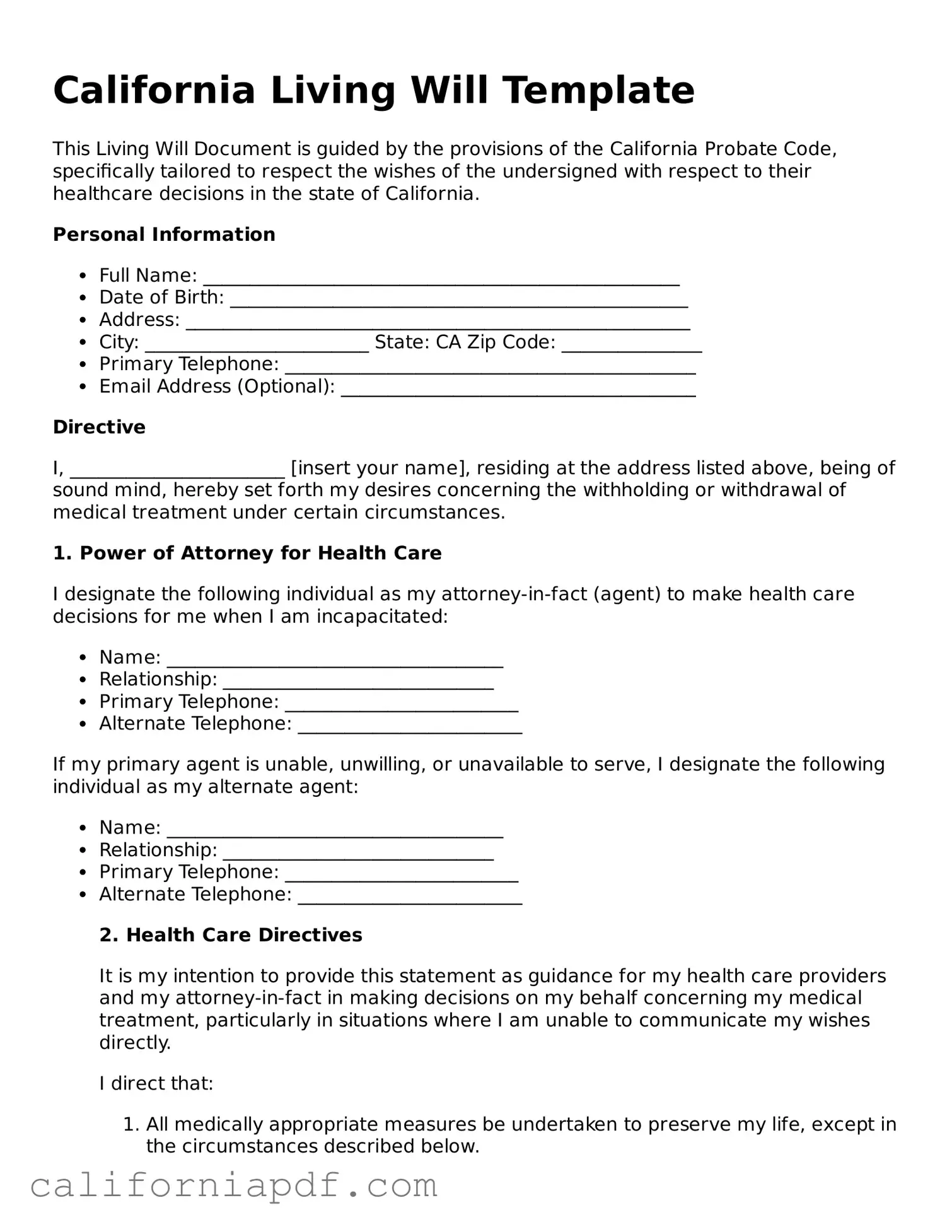The California Living Will, frequently known as an Advance Health Care Directive, bears similarity to a Durable Power of Attorney for Health Care. Both documents allow an individual to make decisions about their health care in advance of incapacity. While a Living Will specifically outlines the types of medical treatments and life-sustaining measures a person wishes or does not wish to receive, a Durable Power of Attorney for Health Care designates an agent to make health-related decisions on behalf of the individual when they are unable to do so themselves. Both play crucial roles in planning for medical care but differ in the scope of authority and decision-making power they grant.
Next, the Do Not Resuscitate (DNR) order shows similarities to a Living Will, as both are advance directives that guide medical treatment preferences. A DNR specifically instructs health care providers not to perform CPR if the patient's breathing stops or if the heart stops beating. It's a narrowly focused document compared to a Living Will, which covers a broader range of medical treatments and life-sustaining measures. However, both are crucial for ensuring that a person's medical treatment preferences are followed during critical times.
A Health Care Proxy is another document similar to the California Living Will. It allows an individual to appoint someone else to make health care decisions on their behalf, similar to the Durable Power of Attorney for Health Care. The key difference is the Health Care Proxy may not necessarily include specific instructions for medical treatment or end-of-life care. Instead, it focuses on appointing a trusted person to make those decisions, relying on personal understanding of the individual’s wishes and values.
The Five Wishes Document goes further by incorporating elements of a Living Will and Health Care Proxy, allowing individuals to specify medical treatments they want or don't want, choose a health care agent, address comfort care, and provide guidance on how they wish to be treated by others and what they want their loved ones to know. This comprehensive document serves as a more holistic approach to end-of-life planning, encompassing personal, emotional, and spiritual desires alongside medical wishes.
Medical Orders for Life-Sustaining Treatment (MOLST) or Physician Orders for Life-Sustaining Treatment (POLST) forms are physician orders that translate a patient’s end-of-life planning preferences into medical orders. They are similar to a Living Will in that they specify the types of medical treatment a patient wants towards the end of life. However, MOLST or POLST forms are more immediately actionable, intended for use by the medical team to ensure the patient’s wishes are followed in real-time medical situations.
A Last Will and Testament, while focused on the distribution of one's estate after death, indirectly shares the philosophy behind a Living Will. Both documents allow individuals to express their wishes and instructions for after they're gone—whether concerning their health care decisions or the distribution of their possessions. Although serving different purposes, each plays a pivotal role in estate planning and personal directive documents.
A Mental Health Advance Directive is akin to a Living Will but focuses specifically on psychiatric care. This document allows individuals to state their preferences for treatment options and to appoint a decision-maker in the event that they're unable to make decisions due to mental illness. Like a Living Will, it's designed to communicate an individual's wishes about their care and ensure they're respected, even when they cannot advocate for themselves.
An Organ Donation Registration form also shares similarities with a Living Will by allowing individuals to make specific health-related decisions in advance—in this case, consenting to or refusing organ and tissue donation after death. Both types of documents ensure a person’s healthcare wishes are known and can be seamlessly executed, thereby relieving family members of making those difficult decisions during times of grief.
The HIPAA Release Form, while not strictly an advance directive, complements a Living Will by granting designated individuals or healthcare providers access to a person’s private health information. This access is crucial for informed decision-making in carrying out the person’s wishes as outlined in their Living Will, especially when detailed medical treatment preferences are documented and need clarification or verification from medical records.
Finally, a POLST (Physician Orders for Life-Sustaining Treatment) Form, though previously mentioned, deserves individual attention for its specific role in immediate medical decision-making. Unlike a Living Will that generally outlines treatment preferences for various scenarios, a POLST form is used for patients who are seriously ill or at the end of life and provides medical orders that are directly actionable in emergency situations—ensuring that the treatments provided or withheld align with the individual’s wishes as closely as possible.
